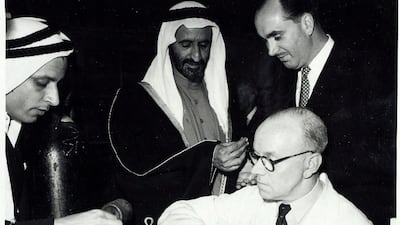Dubai was still a mysterious place to the West in 1959. It was a world of white-robed men and abaya-clad women who lived somewhere among rolling sand dunes in the Middle East.
So the appearance Sheikh Rashid, Ruler of Dubai, in full ceremonial robes on the streets of London that year brought this land of sand and oil into full colour.
Sheikh Rashid travelled to the UK in June with his sons - Sheikh Maktoum, Sheikh Hamdan and Sheikh Mohammed, now the Vice President and Ruler of Dubai. News of the visit of these sheikhs attracted the attention of the UK's press, with photographs and reports of the week-long trip carried in newspapers such as The Times.
Sheikh Rashid held talks with prime minister Harold Macmillan, junior foreign minister John Profumo (who would later resign amid a scandal that convulsed the UK), visited the famed Land Rover factory in Solihull, Birmingham and gazed at the priceless Crown Jewels in the Tower of London.

The remarkable photographs of his visit are online for the first time as part of the Arabian Gulf Digital Archive. But one image stands out – the Ruler casually at the controls of a London Underground train bound for Hounslow.
“For most British schoolboys, here is the dream that remains a dream,” a note in the archives reads.
“But when the Ruler of Dubai - Sheikh Rashid - wished to drive a tube train on London’s famous underground railways the dream became a fact.”
Sheikh Rashid first travelled as a passenger from Piccadilly station to Earl’s Court.
“Then the train thundered on to Hammersmith - but this time driven by the Ruler himself, who was quick to grasp the technique and thoroughly enjoyed this novel experience.”
The picture shows Sheikh Rashid with a knowing smile, watched by what appears to be an eagle-eyed train official in the background.
But the visit was not all trains and jewels. Dubai was then expanding rapidly under Sheikh Rashid’s pro-business rule. Dredgers had cleared Dubai Creek to allow larger ships in for trade, while new businesses, hotels and banks were opening.
But one vital piece was missing – an airport. Sheikh Rashid realised Dubai needed its own terminal, rather than using Sharjah’s which was the primary airport in the southern Gulf since 1932, and went to London to secure permission to build one. Dubai was then a British protectorate.
Sheikh Mohammed bin Rashid recalled the visit in 2016. He noted it was his first trip to London. He was just nine.
“I was a young boy and my father, Sheikh Rashid, took me with him ... My father wanted to build an airstrip in Dubai in the sabkha [salt flat] where the airport is now,” he wrote.
“The British had denied the request for an airstrip, saying that there was a landing strip in Sharjah, where the British base was, so Dubai did not need an airport.
“My father was determined, arguing that he knew what Dubai needed best and he insisted on it. We won permission to build the airstrip on that trip.”
The files do not reveal the details of how Sheikh Rashid managed to convince the British but it is thought he agreed to stump up the money. The airport was built the following year and is now the world’s busiest by international passengers.
The files, meanwhile, also show Sheikh Rashid enjoying a private tour of wax museum Madame Tussauds on Marylebone Road. One image snapped him looking at a figure of Jean Calas in an iron chair. Calas was tortured and executed in France in 1762 for the murder of his son. He was a Protestant in a France that was then formally a Roman Catholic society and his execution spurred allegations of religious intolerance. He was later exonerated.

Sheikh Rashid also visited Garrard jewellers, then located on Regent Street. “The Ruler was particularly interested in seeing pearls being selected and strung into necklaces. Many of the pearls he saw came from the … Gulf.”
However, the most striking image is of the Ruler driving the Tube. It is not clear if Sheikh Mohammed was onboard; the archives do not say. But 57 years later, a Ruler of Dubai would once again step onboard the London Underground.
Sheikh Mohammed, along with his son Crown Prince of Dubai, Sheikh Hamdan, were spotted in 2016 casually riding on the Central Line side by side with other commuters. Proof then, that the legacy of Sheikh Rashid’s common touch lives on.
UAE National Archives
A treasure trove of archives went online this year. Treaties, letters, maps, images and videos shed light on more than 200 years of life in the Arabian Gulf set against the backdrop of war and the search for oil.
The portal, called the Arabian Gulf Digital Archive, is the fruit of two years of work by the UAE and UK. Most of the files are from the UK’s foreign office and provide a fascinating glimpse into the way the British tried to keep a grip on the Middle East, the poverty here following the Second World War and how oil transformed the region.
But the huge archive is also littered with vignettes, diplomatic asides and colourful flourishes that bring these yellowing and faded documents to life. It would take months to pore through them all but here is a small taste of its vast riches.











